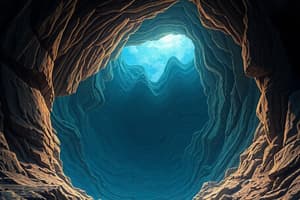Podcast
Questions and Answers
What characterizes a discontinuity within the Earth's layers?
What characterizes a discontinuity within the Earth's layers?
- It marks a sudden change in rock properties. (correct)
- It is a line of volcanic activity.
- It is where the crust meets the atmosphere.
- It is a transition zone of liquid rock.
Which layer of the Earth is primarily liquid?
Which layer of the Earth is primarily liquid?
- Inner Core
- Upper Mantle
- Asthenosphere
- Outer Core (correct)
At what depth does the lower mantle begin?
At what depth does the lower mantle begin?
- 660 km (correct)
- 150 km
- 410 km
- 2980 km
Which layer has pockets of molten rock and is mostly solid?
Which layer has pockets of molten rock and is mostly solid?
What is the temperature range of the lower lithosphere?
What is the temperature range of the lower lithosphere?
What best describes the asthenosphere in terms of its physical behavior?
What best describes the asthenosphere in terms of its physical behavior?
Which layer of the Earth is primarily responsible for the convection process that transfers heat from the core?
Which layer of the Earth is primarily responsible for the convection process that transfers heat from the core?
Which of the following statements regarding the core of the Earth is true?
Which of the following statements regarding the core of the Earth is true?
What phenomenon occurs when an oceanic plate converges with a continental plate?
What phenomenon occurs when an oceanic plate converges with a continental plate?
Which description best defines the lithosphere?
Which description best defines the lithosphere?
Flashcards are hidden until you start studying
Study Notes
Earth’s Interior: An Overview
- The Earth's interior is divided into layers based on chemical composition (crust, mantle, core) as well as physical properties (lithosphere, asthenosphere, mesosphere, outer core, inner core).
- Seismic waves, generated by earthquakes or explosions, travel through the Earth's interior, providing scientists with invaluable information about the composition and density of its layers.
- Seismic waves are slow in the asthenosphere, a region where the high temperature melts rocks, making it behave like a very viscous fluid.
- Seismic waves travel fast again in the mesosphere (lower mantle), indicating a solid state.
- The core is extremely hot, resulting in a molten (liquid) outer core and a solid inner core.
Earth's Crust: The Outer Layer
- The Earth's crust is the thinnest and outermost layer.
- The crust is divided into two types: oceanic and continental.
- Oceanic crust is typically denser than continental crust.
- During subduction, the denser oceanic crust dives beneath the less dense continental crust.
Earth's Mantle: The Middle Layer
- The mantle forms the majority of the Earth's volume, a solid rock layer situated between the crust and the core.
- Mantle convection plays a crucial role in transferring heat from the core to the Earth's surface.
- The mantle has two layers: the lithosphere and the asthenosphere.
Earth's Core: The Center of the Earth
- The Earth's core is extremely hot and dense, located beneath the crust and mantle.
- The core has two layers: the outer core (liquid) and the inner core (solid).
- The movement of the molten outer core generates a magnetic field, which extends from the core to the Earth's surface and beyond.
Earth's Discontinuity
- Discontinuities are boundaries between different layers of the Earth where the properties of the rocks change rapidly, indicating shifts in composition and density.
- The Mohorovicic discontinuity (Moho), for instance, marks the boundary between the crust and the mantle.
Continental Drift Theory
- The Continental Drift Theory proposes that the continents were once joined together in a supercontinent called Pangaea.
- Alfred Wegener, a German meteorologist and geophysicist, formulated the Continental Drift Theory, which was initially met with skepticism from the scientific community.
- Wegener’s evidence for Continental Drift Theory includes topographic similarities, fossil correlations, rock formations, and paleomagnetic evidence.
- Despite strong evidence, the theory was initially rejected because it lacked a convincing mechanism explaining the movement of the continents.
Plate Tectonic Theory
- Plate tectonic theory builds upon Continental Drift Theory, explaining how the Earth's lithosphere is broken into large plates that interact and move along the Earth's surface.
- The asthenosphere, a semi-molten layer below the lithosphere, allows the plates to move.
- Plate tectonics is a major force driving geological activity on Earth, including earthquakes, volcanoes, and mountain formation.
Types of Plate Boundaries
- There are three main types of plate boundaries: divergent, convergent, and transform.
- At divergent boundaries, plates move apart, creating new crust along mid-ocean ridges and rift valleys.
- At convergent boundaries, plates collide. The denser plate subducts beneath the less dense plate. Convergence leads to mountain formation, volcanic arcs, and earthquakes.
- At transform boundaries, plates slide horizontally past each other. Transform boundaries create fault lines, which are associated with earthquakes.
Studying That Suits You
Use AI to generate personalized quizzes and flashcards to suit your learning preferences.




